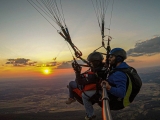Needless to say, one of the most crucial moments in a freestyle skiing mogul run is the jumps—both for the audience, due to their spectacular nature, and for the skier, who knows that a well-executed jump can earn them a significant number of points, essential for securing the coveted victory.
But what criteria do judges follow to evaluate them? What is that jump called? These are some of the questions many skiers ask when attending races held at Spain's ski resorts.

What priorities are used to assess the execution of a jump in mogul skiing?
- Quality, form, and landing.
- Air, height, and distance of the jump.
- Spontaneity
Before delving into possible combinations, let's define the basic manoeuvres permitted in competition and approved by the International Ski Federation (FIS). Any manoeuvre not listed below will be invalid and thus disregarded by the judges.
It’s important to note beforehand that all the jumps we’ll discuss are considered straight jumps, as flips are prohibited in mogul competitions and are reserved exclusively for aerial events.
- Spread Eagle: After takeoff, the arms and legs extend away from the body. The legs must form a minimum 90-degree angle when viewed from the front. The skis must remain parallel (with tips and tails equally extended) and perpendicular to the body. The upper body should stay straight and upright, with no forward lean at the waist. It’s one of the easiest jumps to perform.
- Zudnik: A Nordic-style jump where the upper body bends downward while the lower body extends forward and upward, forming a roughly 90-degree angle at the waist. The skis must stay together and parallel. The knees should be straight, and the head upright. This jump is rarely seen in competition.

- Twister: The skis rotate at least 90 degrees relative to the fall line. The skis must remain parallel, close together, and perpendicular to the body. The hands and arms may move to counterbalance the rotation.
- Daffy: After takeoff, one leg extends forward and upward while the other simultaneously extends backward and upward, resulting in a 180-degree split with both skis parallel and pointing downward.
- Back Scratcher: The tails of the skis point backward and upward, forming a minimum 90-degree angle when viewed sideways. The hips push forward, and the shoulders lean slightly back to counterbalance. The legs must stay together, and the skis parallel.
- Mule Kick: A combination of a back scratcher with a 45-degree lateral hip twist—the traditional "jota."
- Iron Cross: Another back-scratcher variation, with the ski tips crossed at a 90-degree angle while vertical.
- Kosak: A hybrid of a spread eagle and a zudnik. The arms can be positioned differently: forward, between the skis, to the side, or gripping the ski tips.
- Helicopter: A 360-degree rotation of the body around its vertical axis.
These jumps can be combined in sequences of up to four figures, including repetitions. Each competitor must perform at least two distinct jumps. Two jumps are considered distinct if they meet any of the following criteria:
- Different number of positions.
- Jumps from different groups.
- If performing two multi-manoeuvre jumps, they may share the same group combination but must alter the order. Only identical jumps count as repeats. If a jump is repeated, only the highest-scoring attempt will count.

Jump judges must agree on the executed jump. In case of disagreement, the chief judge has the final say. Before each mogul event, the jury, advised by the chief judge, will confirm the number of recommended aerial manoeuvres for the course. The number of jumps will be announced at the final Team Leaders’ meeting before the event. All international competition courses will feature two jumps.
The recommended number of aerial manoeuvres does not restrict the skier but indicates how many jumps will be scored. For example, if the jury recommends two jumps, a skier performing only one will receive just 50% of the total possible score.
Excess jumps beyond the recommended total will be ignored to allow for maximum scoring. If a jump is repeated, only the best attempt will count. For instance, if two aerial manoeuvres are recommended and a skier performs three, judges will score the two best jumps. However, skiers should avoid excessive manoeuvres, as this may negatively impact their turn scores.











